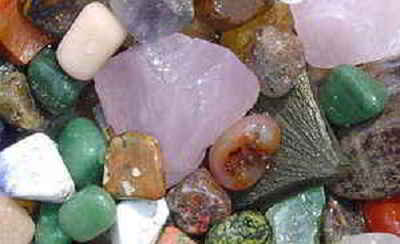

Massachusetts Symbols
Massachusetts State Gem
Rhodonite

((Mn++,Fe++,Mg,Ca)SiO3 )
Adopted in 1979.
RHODONITE is the most beautiful gem material found in the state. It varies in hue from a light pink to a deep rose or reddish pink and is associated with black manganese. It was adopted in 1979 as the gem or gem emblem of the Commonwealth.
Rhodonite is an attractive mineral that is often carved and mostly cut as cabochon jewelry. Faceted stones are rare and highly prized by collectors.
Rhodonite: Massachusetts State Gemstone or Gem

Rhodonite is a manganese inosilicate, ((Mn++,Fe++,Mg,Ca)SiO3 and member of the pyroxenoid group of minerals, crystallizing in the triclinic system. It commonly occurs as cleavable to compact masses with a rose-red color (the name comes from the Greek rhodos, rosy), often tending to brown because of surface oxidation.
Rhodonite was first discovered as float from the glacier during the 19th century where the American Gem Company part of Tiffany & Co., became aware of the float. They used the rhodonite for making knife and umbrella handles as well as dinnerware. There is a place setting on display in the AmericanMuseum of Natural History in New York City made from rhodonite from Massachusetts. The deposit that is at the contact between the Hawley and Savoy schists was developed by Anson Betts who mined the rhodonite for use as flux on welding rods and later mined it as a gemstone. The mine was bulldozed shut after the death of Anson Betts and is now closed to collecting. Rhodonite is still available from the site in the form of mine tailings where it is still collected.
Its rose-pink color is distinctive and can only be confused with rhodochrosite and the rare mineral,
Much rhodonite is found on Vancouver Island, Canada, and the Ural Mountains of the former Russia. Other significant sources include Brazil, Australia, Mexico, South Africa, Madagascar, Sweden & the United States. One domestic source for rhodonite is the state of Massachusetts.

Rhodonite is a pink to red colored gem that contains black veins of manganese oxide. This unusual combination of pink and black make rhodonite quite easy to distinguish from other gems. Because of its' black veins, rhodonite was once thought to be pink turquoise. This turned out to be totally inaccurate.
Rhodonite is most commonly found in an opaque form cut en cabochon. It is also sometimes found in lovely beads of pink and red. Although some rhodonite has been found in its crystal form, this variety is quite rare and seldom (if ever) seen at retail.
Massachusetts Laws
The law designating Rhodonite as the official Massachusetts state gem or gem emblem is found in the General Laws of Massachusetts Part I Title I Chapter 2 Section 15.
PART I ADMINISTRATION OF THE GOVERNMENT
TITLE I JURISDICTION AND EMBLEMS OF THE COMMONWEALTH, THE GENERAL COURT, STATUTES AND PUBLIC DOCUMENTS
CHAPTER 2 ARMS, GREAT SEAL AND OTHER EMBLEMS OF THE COMMONWEALTH
Section 15 Gem or gem emblem of commonwealth
Section 15. Rhodonite shall be the gem or gem emblem of the commonwealth.
General Silicates Information
Chemical Formula: (Mn++,Fe++,Mg,Ca)SiO3
Composition: Molecular Weight = 129.13 gm
Calcium: 1.55 % Ca 2.17 % CaO
Magnesium: 0.38 % Mg 0.62 % MgO
Manganese: 38.29 % Mn 49.44 % MnO
Iron: 0.86 % Fe 1.11 % FeO
Silicon: 21.75 % Si 46.53 % SiO2
Oxygen: 37.17 % O
Total: 100.00 % 99.88 % = TOTAL OXIDE
Empirical Formula: Mn2+0.9Fe2+0.02Mg0.02Ca0.05SiO3
Environment: Hydrothermal, metamorphic and, metasomatic rocks.
IMA Status: Valid Species (Pre-IMA) 1819
Locality: Much rhodonite is found on Vancouver Island, Canada, and the Ural Mountains of the former Russia. Other significant sources include Brazil, Australia, Mexico, South Africa, Madagascar, Sweden & the United States.
Name Origin: From the Greek rhodos - "rose colored."
Minerals, & Gems

Gemstone, Minerals, Rocks





